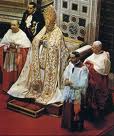 Today the universal Church celebrates the feast of the Chair of St. Peter. When I first returned to the Church way back when, I thought this feast sounded really strange. I was okay with celebrating events from the life of Christ, and even with celebrating feasts in honor of special saints. But a chair?
Today the universal Church celebrates the feast of the Chair of St. Peter. When I first returned to the Church way back when, I thought this feast sounded really strange. I was okay with celebrating events from the life of Christ, and even with celebrating feasts in honor of special saints. But a chair?
Then I read that ever since the fourth century, the feast of the Chair of St. Peter has been celebrated in Rome as a sign of the unity of the Church founded upon that apostle. Hmmm. There must be more to the story . . .
One thing I learned early on is that the word for “chair” in Latin is cathedra. And so when the Pope teaches authoritatively in the area of faith and morals, he is said to speak “ex cathedra,” or “from the chair,” indicating the binding nature of the teaching on the Christian faithful.
And because cathedra literally refers to the established seat of the bishop, the “mother church” of a diocese that contains this seat is known as a “cathedral.” The chair or seat of a bishop symbolizes his authority as a successor of the apostles, and in a special way it symbolizes his “magisterium” or teaching office, in that he called to guard and proclaim the deposit of faith for the benefit of the local Church.
As Pope Benedict teaches, “When the bishop takes possession of the local Church that is entrusted to him, he, bearing the miter and the shepherd’s crosier, sits on the cathedra. From that seat he will guide, as teacher and shepherd, the journey of the faithful in faith, hope and charity.”
The first “seat” of the Church was the Upper Room where, in all probability, there was a special place reserved for Simon Peter as they awaited the outpouring of the Holy Spirit (see Acts 1:13-15).
From there the “seat” of Peter moved to Antioch, the city where “for the first time the disciples were called Christians” (Acts 11:26), as Peter became that community’s first bishop
From there, providence led Peter to Rome, where his service to the Gospel was crowned with martyrdom.
In this way, Rome came to be known as the “See” of the successor of Peter and the “cathedra” of its bishop, as it represents the mission entrusted to him by Christ to shepherd His entire flock. Incidentally, the Pope’s cathedral is not St. Peter’s, but St. John Lateran Basilica in Rome, identified as the “Mother and Head” of all the churches in the world.
Rome’s significance as the See of Peter is attested by the most ancient Fathers of the Church. For example, St. Irenaeus, Bishop of Lyon (c. 200 A.D.), described the Church of Rome as “greatest and most ancient, known by all; . . . founded and constituted at Rome by the two glorious Apostles Peter and Paul . . . With this Church, because of her outstanding superiority, the universal Church must be in agreement, that is, the faithful everywhere” (Against Heresies).
In celebrating the “Chair” of Peter we recognize its spiritual significance: It is a special sign of the love of Christ who, as one form of the penitential rite at Mass provides, came to “gather the nations into the peace [and unity] of God’s kingdom.” Let us today and always make our own the words of St. Jerome: “I follow no leader save Christ so I consult the chair of Peter, for this I know is the rock upon which the Church is built!”
This article originally appeared at the Catholic Hour blog. Also check out this post by Dr. Scott Hahn.